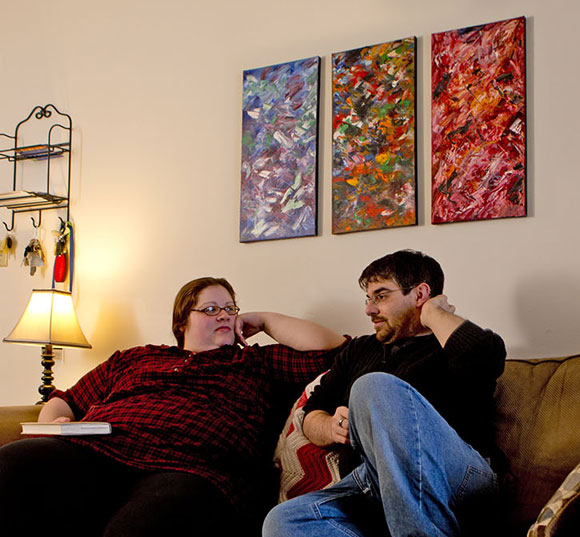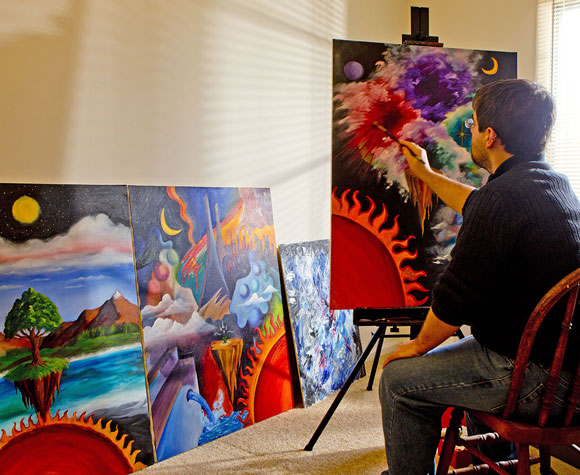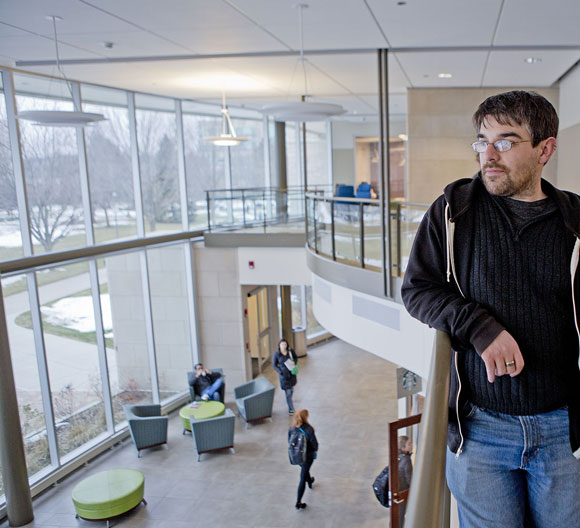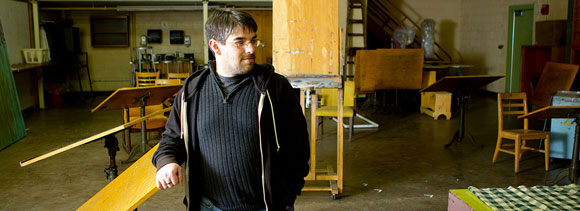South Bend, Ind. — Every month, $64 is withdrawn from Tony Havens’ checking account to pay off his student loans. For him, it’s both a financial hit and a grim reminder that he spent five years in college and left with approximately $15,000 in debt … but no degree.
What makes it even more painful is that with better guidance and a little more information about his finances, Havens, 33, most likely could have graduated from Indiana University-South Bend in four years. Instead, he still needs roughly another year of credits to earn his degree.
“I didn’t realize that my scholarship would only cover me for four years, and I ended up taking history and political science courses before I finished the requirements for my degree,” said Havens, sitting in his apartment, which is roughly two miles from the IUSB campus. “If I had it to do over again, I would have focused on the requirements that I needed to graduate and completed my degree in drawing and painting.”
Havens accepts the lion’s share of the blame for what happened to his college career. He just wishes someone had told him then what he knows now.
‘Sign it. Just sign it. It’s good’
Havens remembers being called to his guidance counselor’s office while in middle school and signing up for the 21st Century Scholars program — a state-funded program that gives lower-income students the opportunity to earn up to a four-year scholarship at an Indiana college or university.
In signing the pledge, Havens joined other would-be Scholars who promise to stay on top of their grades, complete college-preparation activities and stay drug- and alcohol-free. In exchange, they receive tuition assistance — this year, it’s slightly more than $7,500 a year to attend a four-year public university, or $3,900 a year for a two-year school. The money does not cover room and board or books.

“I was like, ‘I don’t even know what it’s about,’” Havens recalls. “And the counselor was like, ‘Sign it. Just sign it. It’s good.’”
So he did. Between then and 2000 — when he graduated from Penn High School in Mishawaka, Ind. — he doesn’t remember hearing another word about the scholarship. It wasn’t until he applied for financial aid to get into IUSB that the university reminded him the money was waiting. Between those funds and a Pell Grant, his education was covered.
Emily Sellers, director of outreach and engagement for the Indiana Commission for Higher Education, which oversees the 21st Century Scholars program, said it’s entirely likely that Havens never heard anything else about the scholarship. “That’s something we’re improving,” she said. These days, recipients of the scholarship receive direct, frequent, student-friendly correspondence. They also participate in a new Scholars Success Program, which helps them learn to plan, prepare and pay for college.
“The Indiana commission is working hard to ensure Scholars are better prepared at the secondary level and better supported once they arrive on our college and university campuses,” she added in an e-mail. “We have developed new systems to better support and track Scholar program and success throughout high school and have bolstered our postsecondary-level supports to ensure students are persisting to an on-time degree.”
In fall 2000, Havens became the first in his family to go to college. He looked at three schools and chose IUSB for its proximity to home — he would be a commuter — and its art program, which focused on realism rather than abstraction. He enrolled as a fine arts, drawing, and painting major. And for three years, he followed that path toward a degree.
Havens had been creating art since he was young and said he learned a lot in college. To this day, he uses what his IUSB professors taught him about painting with oils as opposed to watercolors and acrylics. That knowledge is on display in the apartment he shares with his girlfriend, Jessica Platz, 29. There, in a bedroom he converted to a studio, he’s completing a series of futuristic, vibrant oil paintings that he started at IUSB. “I just picked up a brush, dabbed it in paint and started to come up with the rough sketch of what that ended up being,” he said. “A friend of mine said the first one would be ‘creation,’ this second one would be ‘the midway point,’ and the one I’m finishing now is ‘decay.’ I thought that was a pretty good explanation.”

As much as he enjoyed — and still enjoys — art, though, Havens began to feel that he might need a more secure career than his major could provide. One of his more influential professors, Ron Monsma, understands that position, but he doesn’t necessarily support it. He insists that businesses look for people with arts degrees because employers can teach them how to do certain things, but they can’t teach them how to be creative.
“I give them grounding that will enable them to do what they want to do for the rest of their lives at a higher-skilled level,” he said. “Maybe they won’t get a job doing it; no one gets a degree in drawing and painting and walks into a gallery and hands the director their sheepskin and says, ‘Where do I hang my work?’” But art students find work, he said. Many become teachers — and some do become artists.
‘Sidetracked by other interests’
Havens didn’t want to be a teacher. “It takes a very special person to teach and teach well, and I don’t believe I would fit that mold,” he said. So he spent much of his fourth year taking history and political science courses — so many that, if he had graduated, he would have earned minors in both subjects. At the time, he remembers, his faculty adviser asked why he wanted to take so many courses outside his major. Havens’ answer: I want to know more. His adviser’s response: That’s not a bad thing.
No, but it did put Havens far behind where he needed to be to finish his degree in four years.
“I got sidetracked by those other interests,” Havens said, “and I didn’t realize the scholarship would only cover me for four years. I would have liked to have somebody tell me that, because I would have planned things out a little differently, definitely. I would have focused on the classes I needed for my major and then, if I was done with that, if I still wanted to go through with the other classes that interested me, I would have been able to afford that with just the Pell Grant. I could have taken one class a semester and started to work.”
But the scholarship did, in fact, run out. For two semesters, Havens borrowed money to fund his education, but “I decided I didn’t want to continue to take out loans for a major in drawing and painting because I was pretty certain that I would end up working at a place like Walgreens — which is where I did end up — having to pay back a large amount of debt.”

Havens was a little ahead of his time when it came to fear of student loan debt. “But back when he was a student,” said Jamie Dickenson, a West Virginia-based education planner, “the interest rates on student debt were much lower than they are now. I remember when student loan rates were 2.2 percent and parent loan rates were 3.2 percent. That was doable. When the cost of college attendance shot through the roof, coupled with 8.45 percent on student loans, that is when things became unbearable.”
Havens said universities could help people like him by laying out a financial plan when students start school and conducting a yearly review of financial aid and loan balances. “You’d be able to know the financial situation you’re going to find yourself in when you leave,” he said. “I’ve met a lot of people who’ve gone to school, and they did what I did to a greater degree and left with a lot of debt. They didn’t even realize how much debt they were getting into.”
After his fifth year, Havens had amassed $15,000 in debt — to pay for school, for a car to get him to and from school, and for housing. He had lived at home for the first three years of school, but then he was on his own, paying rent to live in his uncle’s house.

Havens liked school, and he had the intellectual curiosity to continue. But his art classes required so many hours in the studio that it was next to impossible for him to hold a job, and he worried about paying off the loans. So in 2005, feeling “burnt out,” he left school.
Havens didn’t expect to be out of school for what’s now approaching 10 years. “I take what responsibility I can for the decisions that I made because it was my decision to discontinue going,” he said. “I can’t blame that on anybody else, and wouldn’t.” But he has plenty of company among 21st Century Scholars. Only 15 percent earn their associate or bachelor’s degree on time (compared with 23 percent of all Indiana public college students), and only 33 percent graduate after three or six years (compared with 42 percent for all Indiana public college students).
Good start, painful finish in retail
After Havens left school, he took a job at a CVS store. He spent two years there, then moved over to Walgreens, where he started making “really good money” as an assistant manager. But six years in, after several cuts in pay and benefits, the job lost its allure — in part because it forced him to be on his feet all day. “I would get home from work in retail and my feet would throb,” he said.
He tried unsuccessfully four times to land a position with a national insurance company in South Bend. The fifth time, though, he was hired. In September 2014, he started as a customer service representative and licensed insurance agent, working a 1:30-10 p.m. shift.
Still, he said, there’s that nagging feeling that he should have completed college. “I would really like to finish my degree,” he said. “I don’t want to just throw away all that work that I did.” He and Platz — who also has a year of college remaining and works for the same firm that employs Havens — said they talk often about the subject.
But they’re expecting their first child — a girl — in May, “so it’s more like a timeline kind of conversation,” Platz said. “For me, it’s the debate of: ‘How long do you wait after the baby is born to figure out going back to school and working while trying to raise a family?’
“We’ve both said we want to settle into more of a family rhythm to be able to know where we’re going from here,” she added. “But we both have a strong desire to finish. It’s something neither of us has lost sight of.” For Havens, though, it’s becoming harder to see the finish line — and to chart a path that will get him there. When he checked with the registrar’s office in January to see how many credits he needs to graduate, he couldn’t get a clear answer. IUSB officials told him that he’s been out of school so long that it won’t be easy to determine how far he has to go.
“The only info I was able to gather on my progress was that I was over halfway,” Havens said. “They said the program has changed so much that it would take a lot of evaluation to determine how much needs to be done to graduate.” ■
